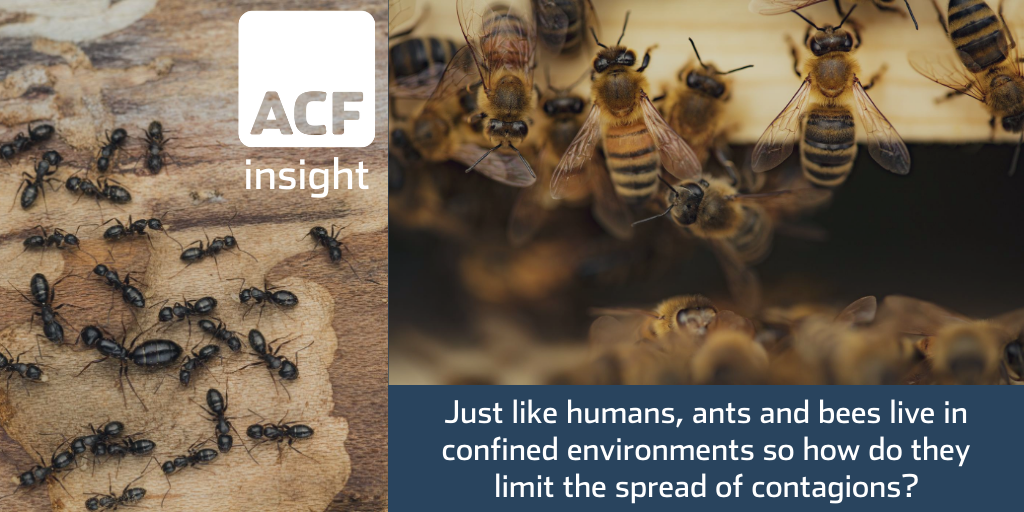What can ants and bees teach us about containing disease
Nathalie Stroeymeyt, a senior lecturer in the School of Biological Sciences at the University of Bristol, drew parallels from the guides to social distancing during the Covid-19 pandemic and how ants behave in a recent research study.
The research was carried out by placing QR codes on individual ants in order to monitor their actions and positions within the colony.
Stroeymeyt believes that these findings could help human beings “imagine a more pandemic-resilient society”.
- Social insects – termites, ants, bees and wasps – like humans, share close quarters.
- However, social insect researchers have found that even though these insects live in confined environments and are susceptible to a lot of microbials (bacteria that cause diseases) they are able to limit the spread of contagions.
- They do this by grooming each other and themselves frequently and keep clean living spaces. But also because instinctively they will change their behaviour to limit interactions when there is a risk of infection.
- In ants, researchers found that via grooming they transfer small amounts of pathogens to each other, but the levels are so low and non-lethal and ‘trigger a protective immunization’. A similar method called variolation was used to immunize human beings from smallpox by exposing them to a small amount of fluid from a person infected with smallpox.
- Studies also found that the black carpenter ant colony is able to develop its own immune response to bacteria and transfer that to its nestmates.
- Researchers have analysed social insects to determine whether or not they change how they interact in order to avoid diseases from spreading. We can see this in ants that have a pre-existing division of labour, e.g. the queen only interacts with a few workers and therefore can avoid getting sick.
- Stroeymeyt believes that this form of ant distancing is not so far off from what humans have been asked to do as a result of the Covid-19 pandemic.
- A University of Tennessee researcher observed termite cannibalism and how they eat their young when exposed to a bad outbreak. She compares this to the school’s closures, i.e. separating the kids from the masses as they are more likely to spread diseases a lot faster than adults due to their frequent interactions with each other.
Research is extremely important in healthcare. Through research medical professionals are able to develop new drugs, improve existing drugs, deliver a more accurate diagnosis and discover treatments that are bespoke.
But what are the cost implications to the healthcare industry?
According to PwC’s ‘Global Innovation 1000 Study’ healthcare will rank the highest of all industries on R&D spending by 2020 at USD 185bn. We have run our own forecasts out to 2025 and come to a different conclusion.
Exhibit 1 illustrates R&D spending by industry. We have provided our own forecast based on a 5-year CAGR for each sector through to 2025. In 2020E we forecast that healthcare will have the second highest ranking R&D spend at $233bn with a CAGR of 5%, nevertheless the story is more complex than our forecasts suggest as we describe below.
Exhibit 1 R&D Spending by Industry, 2015-2025E

Source: ACF Equity Research; Capital IQ data, Thomson Reuters Eikon data; PwC.
The data above presents a lucrative opportunity for investors as well as opportunities for small and mid-cap companies to compete with big pharma. We forecast that healthcare R&D spending will exceed 50% of the value of R&D spend on computing and electronics. There is also the unavoidable conclusion that software and internet R&D spend will manifest into healthcare services.
If there was any doubt before Covid-19, the intimate link between healthcare R&D and information technology R&D that makes up the future of healthcare is here now for all to see.
Hospitals, clinics and other medical providers have all had to adjust their business operations in order to make use of telehealth/telemedicine systems, essentially software and internet innovations.
Social media platforms have become a source of information for the majority of the population.
The link between healthcare and technology and the increase in R&D, not only refreshes the attractiveness of the healthcare industry as an investment opportunity (after two decades in the relative doldrums and investor jadedness), but our forecasts also suggest a further broadening of the opportunities for smaller companies entering niche healthcare markets, generics, biosimilars and software and internet related healthcare services.
















